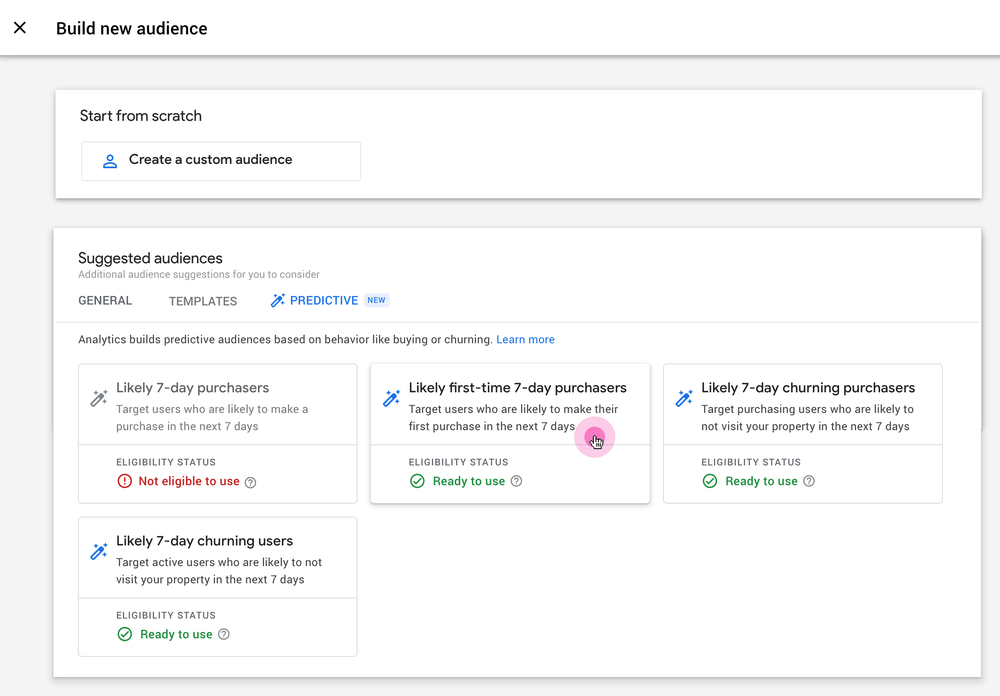Google ADS and not only: the latest news on Google advertisements
It’s a time of great turmoil at Google Ads’: in recent days, the system of paid ads in the search pages of the US giant has in fact obtained a number of interesting additional features, that allow users to develop more targeted and effective campaigns, but also new services and policy changes. Let’s try to get some order!
Reaching the predictive audience with Google Ads
Let’s start with perhaps the most important news, announced by Steve Ganem (Senior Product Manager of Google Analytics) on the The Keyword blog: Google introduces two new metrics to encourage the growth of online activities and improve the management of the budget for marketing, as they give the possibility to reach through Google Ads people who are more likely to buy and intercept with the right strategy people who may not return to their app or site.
Thanks to Google Analytics, which helps measure the actions that people take through apps and websites, you can now get tips on new predictive audience segments that you can create in Audience Builder, taking advantage of the applications of Google Analytics machine learning models, which allow you to analyze site data and predict future actions that people might take.
Two new metrics to get to know and segment the audience
The new system is based on two new predictive metrics, available in the App + Web properties (initially for properties that have implemented purchase events or that automatically measure in-app purchases once certain thresholds are reached):
- Purchase Probability serves precisely to predict the probability that users who have visited the app or site buy in the next seven days.
- Churn Probability estimates the probability that recently active users will not visit the app or site in the next seven days.
The benefits of predictive features on the audience
So far, Ganem explains, those who wanted to reach the people who were most likely to buy had to generally create an audience “of people who had added products to their shopping carts but had not bought”. Nevertheless, “with this approach you are likely to lose people who have never selected an item but who could purchase it in the future”.
On the contrary, the predictive audience identification “automatically determines which customer actions on an app or site could lead to a purchase”, helping us find more people on a large-scale who could make a conversion.
The article also quotes a practical example to explain the new approach: “Imagine running a home store and trying to boost digital sales this month“, writes Steve Ganem. With the predictive method, “Analytics will now suggest an audience that includes all those who could buy in the next seven days, both on your app and on your site, and then you can reach them with a customized message using Google Ads”.
Or, “suppose you are an online publisher and want to keep your average number of daily users”: you can “create an audience of users who will probably not visit your app or site in the next seven days and then create a Google ad campaign to encourage them to read one of your popular articles”So we use the information to reverse the probability.
Tools to analyze the clients’ activities
But the uses of this tool do not stop at building an audience, because predictive metrics can also serve to analyze your data with the Analysis form. For example, the Senior Product Manager of the Californian company continues, “you can use the User Lifetime technique to identify which marketing campaign has helped you to acquire users with the highest probability of purchase”, and thanks to this information, you can decide to reallocate your marketing budget to that high-potential campaign.
Google Ads bans spywares and surveillance technologies
The second news related to Google Ads is not about a feature, but rather an important update of the policy rules to avoid the soliciting of dishonest behavior. Starting from August 11th, more stringent rules on advertising for spywares and surveillance technologies will come into force globally.
Basically, it will be prohibited on Google Ads “the promotion of products or services that are marketed or directed to customers with the explicit purpose of locating or monitoring another person or his activities without his permission”.
From August ads will be forbidden for some products and service categories
Specifically, the company announces that it will no longer be allowed the publishing of ads concerning spyware systems and technologies “used for the surveillance of the private life of the partner” (including spyware/malware technologies to monitor SMS, phone calls or browsing history, GPS detectors specially marketed to spy on or control someone without their consent), as well as the “promotion of surveillance equipment (camcorders, audio recorders, dash cams, nanny cams) offered for sale with the explicit purpose of spying”.
Instead, it will be still possible to continue to promote on the Google network private investigation services and products or services intended for parents to locate or monitor their minor children.
Here come the 3D ads
It is instead a real technological innovation that started with Swirl, the format of 3D interactive display ads for mobile devices that Google began testing last year and that is now available globally for Display & Video 360 customers.

During the test period, the brands that used the Swirl ads (including Purina, Nissan, Adidas and Belvedere Vodka) have had great success for several goals of their campaign. In particular, he points out an article on Google’s blog, “a growing appreciation thanks to the presentation of product features, brand awareness building and offering an excellent mobile experience”.
Google reveals its commissions for ads
The last news we focus on is the very operation of Google’s advertising system: for the first time, in fact, the giant of Mountain View has revealed the amount of its advertising fees, and then admitted what remains in the company’s pockets when a brand or publisher buy or sell ads on Google’s network.
In 2019, when marketers used Google Ads or Display & Video 360 to buy display ads on Google Ad Manager, publishers kept 69 percent of the revenue generated, while Google went 31 percent. So if a brand spends 1 dollar to buy space on Google’s entire advertising chain, the publisher gets 69 cents while Google gets 31.
How much it truly is to advertise on Google
The long article on the Google blog also reports other cases, and in particular focuses on the use of Google Ads, which leaves on average 14 percent of every dollar spent in Google’s pockets. This figure, however, is very variable, as the price for brands is calculated on the basis of a cost per result, while publishers are paid in CPM – cost per thousand impressions delivered.
However, some analysts have noted that this “transparency operation” of Google actually presents some shadows: for example, publishers might pay different prices for the sale of spaces through different ad exchanges or DSPs, and also the examination shortens the advertising sold in open bidding with that sold through Ad Manager (whose revenues are clearly different: 5/10 percent for the first, 20 percent for the second). Last but not least, the article does not mention the contribution of Adsense.



